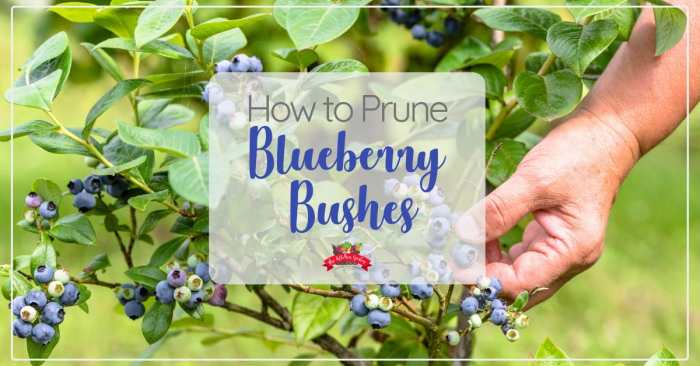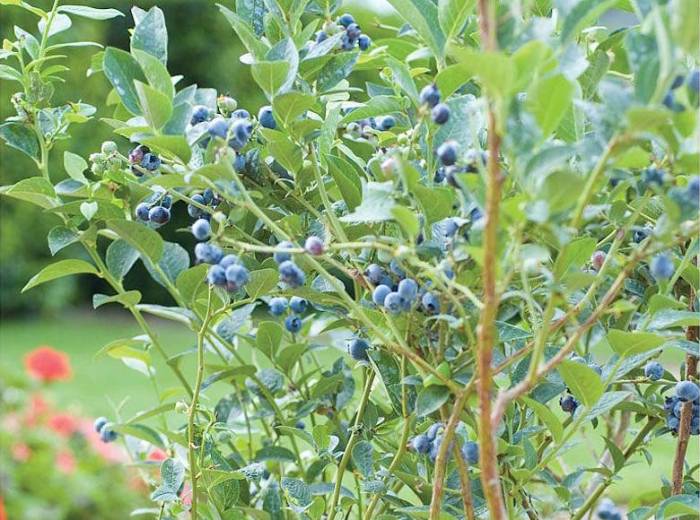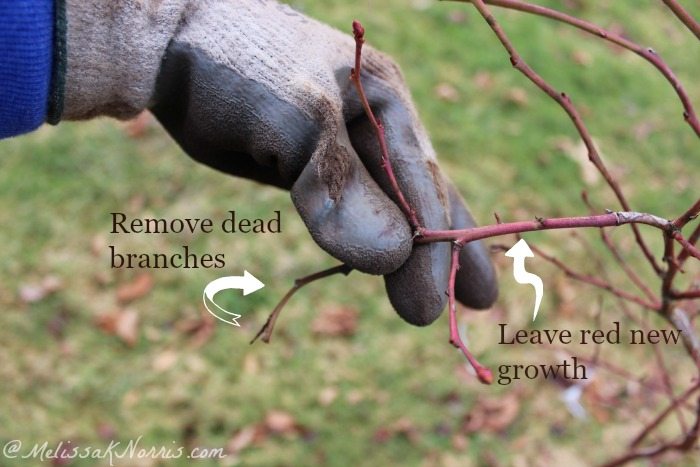How to trim blueberry plants – Delve into the art of blueberry plant trimming with this comprehensive guide. Discover the importance, techniques, and benefits of this essential gardening practice, unlocking the secrets to maximizing plant health and fruit quality.
Understanding the Basics of Blueberry Plant Trimming
Blueberry plant trimming is a crucial aspect of blueberry cultivation that contributes to the plant’s overall health, productivity, and fruit quality. Proper trimming techniques promote healthy growth, maximize sunlight exposure, enhance air circulation, and prevent disease infestations.
Ideal Time for Trimming Blueberry Plants
The ideal time to trim blueberry plants is during the dormant season, typically late winter or early spring before new growth begins. This allows for the removal of old, unproductive canes and the shaping of the plant for optimal fruit production.
Choosing the Right Tools for Blueberry Plant Trimming
The choice of tools for trimming blueberry plants depends on the size and age of the plant. For small plants, sharp pruning shears or secateurs are sufficient. For larger plants, loppers or hand saws may be necessary to remove thicker canes.
Techniques for Trimming Blueberry Plants: How To Trim Blueberry Plants

Trimming blueberry plants is essential for maintaining their health and productivity. There are several methods for trimming blueberry plants, each with its own advantages and disadvantages.
The most common method of trimming blueberry plants is called renewal pruning. Renewal pruning involves removing the oldest canes from the plant each year to encourage new growth. This helps to keep the plant vigorous and productive.
Another method of trimming blueberry plants is called heading back. Heading back involves cutting back the tips of the canes by about one-third. This helps to promote lateral branching and can improve the plant’s fruit production.
A third method of trimming blueberry plants is called hedging. Hedging involves cutting the sides of the plant back to a desired height. This helps to keep the plant compact and can make it easier to harvest the fruit.
The best method of trimming blueberry plants will depend on the age and size of the plant, as well as the desired results. It is important to consult with a qualified arborist or horticulturist before trimming blueberry plants.
Renewal Pruning
Renewal pruning is the most common method of trimming blueberry plants. It involves removing the oldest canes from the plant each year to encourage new growth. This helps to keep the plant vigorous and productive.
To perform renewal pruning, follow these steps:
- Identify the oldest canes on the plant. These canes will be the thickest and darkest in color.
- Cut the oldest canes back to the ground.
- Repeat steps 1 and 2 until you have removed about one-third of the canes from the plant.
Heading Back
Heading back involves cutting back the tips of the canes by about one-third. This helps to promote lateral branching and can improve the plant’s fruit production.
To perform heading back, follow these steps:
- Identify the canes that you want to head back.
- Cut the tips of the canes back by about one-third.
- Repeat steps 1 and 2 until you have headed back all of the desired canes.
Hedging
Hedging involves cutting the sides of the plant back to a desired height. This helps to keep the plant compact and can make it easier to harvest the fruit.
To perform hedging, follow these steps:
- Identify the desired height for the plant.
- Cut the sides of the plant back to the desired height.
- Repeat steps 1 and 2 until you have hedged the entire plant.
Benefits of Trimming Blueberry Plants
Trimming blueberry plants is essential for maintaining their health, productivity, and fruit quality. It promotes healthy growth, improves airflow and sunlight penetration, and reduces the risk of pests and diseases.Regular trimming stimulates new growth and removes old, unproductive canes. This encourages the plant to produce more vigorous and fruitful shoots.
By opening up the canopy, trimming allows better air circulation and sunlight penetration, which reduces the risk of fungal diseases and enhances fruit ripening.
Improved Fruit Size and Quality
Proper trimming significantly affects the size and quality of blueberry fruits. When the plant is well-maintained, it can allocate more resources to fruit production, resulting in larger and more flavorful berries. Trimming also removes weak or damaged canes that would otherwise compete for nutrients, allowing the remaining canes to produce healthier and more abundant fruit.
Common Mistakes to Avoid When Trimming Blueberry Plants

Trimming blueberry plants is a crucial step in maintaining their health and productivity. However, several common mistakes can compromise the plant’s well-being and hinder fruit production.
Over-trimming:Removing too much foliage can weaken the plant, reduce fruit yield, and expose it to pests and diseases. Only prune dead, diseased, or overcrowded branches.
When trimming blueberry plants, it’s important to remove any dead or diseased branches. You can also trim back overgrown branches to encourage new growth. For more home gardening inspiration, check out 10 Hanging Plants Pinterest: Beautify Your Home with Greenery . Once you’ve trimmed your blueberry plants, water them deeply and fertilize them according to the manufacturer’s instructions.
Improper pruning technique:Using dull or unsterilized tools can introduce diseases into the plant. Always use sharp, clean tools and make clean cuts at a 45-degree angle.
Trimming at the wrong time:Avoid pruning during the growing season, as it can stimulate excessive vegetative growth and reduce fruit production. Trim in late winter or early spring when the plant is dormant.
Neglecting the lower branches:Failure to trim the lower branches can create a dense canopy, reducing airflow and sunlight penetration, leading to poor fruit quality and increased disease susceptibility.
When trimming blueberry plants, it’s crucial to use sharp, clean shears to avoid tearing the stems. To maintain optimal plant health and productivity, remove any dead or diseased branches and thin out overcrowded areas. While trimming, you might find 10 Hanging Plants Revit Family Free Download: Enhance Your Designs with Realistic Greenery as a helpful resource for adding life and greenery to your surroundings.
Remember to cut back overgrown canes to encourage new growth and improve fruit production.
Incorrect pruning cuts:Avoid leaving stubs or cutting too close to the main stem, as this can create entry points for diseases and pests.
Additional Considerations for Trimming Blueberry Plants

Trimming blueberry plants requires special attention to different varieties and climate conditions. Understanding these factors ensures optimal plant health and productivity.
Trimming blueberry plants is essential for maintaining their health and productivity. When trimming, remove any dead or diseased branches and cut back the oldest canes to encourage new growth. You can also prune the plant to shape it or to make it easier to harvest the berries.
If you’re looking for a way to add some greenery to your home without taking up too much space, consider hanging plants . They’re a great way to add a touch of nature to any room, and they can also help to improve air quality.
Plus, they’re easy to care for and can thrive in a variety of conditions. Once you’ve finished trimming your blueberry plants, be sure to water them well and fertilize them according to the manufacturer’s instructions.
Special Considerations for Different Varieties, How to trim blueberry plants
- Highbush blueberries:Require more extensive pruning than other varieties to promote new growth and prevent overcrowding.
- Lowbush blueberries:Typically require minimal pruning, but removing old canes and suckers can improve fruit production.
- Rabbiteye blueberries:Have a naturally upright growth habit and require less pruning than other varieties.
Trimming Blueberry Plants in Different Climates
Climate conditions can influence the frequency and intensity of trimming.
- Cold climates:Prune in late winter or early spring before new growth emerges.
- Warm climates:Prune in late winter or early spring, but avoid trimming too early as it can encourage excessive growth.
Fertilizers and Supplements After Trimming
Fertilizing and providing supplements after trimming can support plant recovery and growth.
To trim blueberry plants, start by removing any dead or diseased canes. Then, prune back the remaining canes by about one-third. This will help to encourage new growth and improve the plant’s overall health. For more home decor tips, check out our article on 10 Hanging Plants to Elevate Your Rental Apartment . After trimming, fertilize the plant and water it deeply.
With proper care, your blueberry plants will thrive and produce an abundance of fruit for years to come.
- Fertilizers:Apply a balanced fertilizer specifically formulated for blueberries.
- Mulch:Spread organic mulch around the plants to retain moisture, suppress weeds, and regulate soil temperature.
Closure

By following the expert advice Artikeld in this guide, you’ll be well-equipped to trim your blueberry plants with confidence, ensuring optimal growth, bountiful harvests, and years of fruitful enjoyment.
Q&A
When is the best time to trim blueberry plants?
The ideal time for trimming is late winter or early spring, before new growth begins.
What tools do I need for trimming blueberry plants?
Sharp hand pruners, loppers, and a pruning saw are essential tools for effective trimming.
How often should I trim blueberry plants?
Regular trimming every 2-3 years is recommended to maintain plant health and productivity.